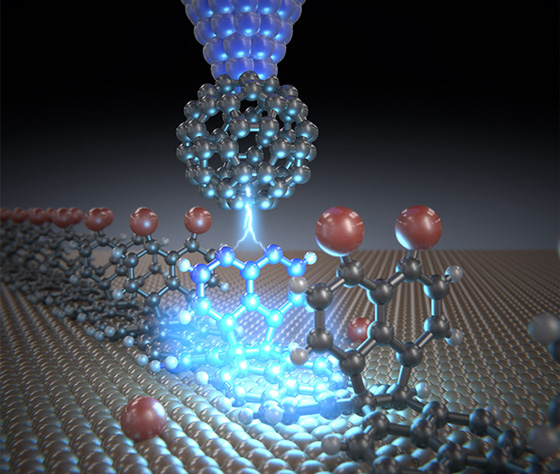- Home
- > Research
- > Research Highlights
- > Vol. 59 AFM’s Probe Used to Induce Che・・・
 Research Highlights
Research Highlights
[Vol. 59]
AFM’s Probe Used to Induce Chemical Reactions at Specific Sites on Single Molecule
A team at MANA has demonstrated controlled addition reactions at specific sites on a single molecule by using an atomic force microscope’s (AFM) local probe at low temperature. This work enables the synthesis of functional carbon nanostructures that cannot be obtained by conventional chemistry. Thanks to their superior electrical properties, such nanostructures are expected to find applications in nanoelectronic devices.

The team synthesized three-dimensional graphene nanoribbons (3D-GNR) by on-surface chemical reaction. Then, taking advantage of the AFM’s ability to conduct tip-induced assembly, they demonstrated the nanoribbons’ capability as a framework for local probe chemistry. This could allow sequential reactions, particularly addition reactions (in which two molecules combine to create a bigger one), by a local probe at the single-molecule level.
The AFM’s probe, terminated with a small carbon monoxide molecule, allows direct observation of the inner structures of both single molecules, as well as the products of on-surface chemical reactions.
It also allows researchers to conduct single molecule chemistry via tip-induced reactions. The local probe can be used to generate highly reactive radical species by tip-induced dehydrogenation, dehalogenation or deoxidization on surfaces. However, since these organic redox reactions are conducted with planar molecules, the molecule-substrate interaction has to be reduced by inserting thin insulating films. In contrast, if a 3D hydrocarbon is used, the out-of-plane moiety can be used for local probe chemistry in a similar way to recent measurements of intermolecular interactions.
The MANA team noted that direct addition reactions at specific sites like the ones they demonstrated can advance chemistry toward synthesis of single compounds atom by atom. Such extremely fine control offers the ability to create unprecedented new functional materials.
This research was carried out by Shigeki Kawai* (Principal Researcher, Nano Functionality Integration Group, Nano-System Field) and his collaborators.
*Present affiliation: Group Leader, Nanoprobe Group, Nano Characterization Field, Research Center for Advanced Measurement and Characterization, NIMS
*Present affiliation: Group Leader, Nanoprobe Group, Nano Characterization Field, Research Center for Advanced Measurement and Characterization, NIMS
Reference
“Three-dimensional Graphene Nanoribbons as a Framework for Molecular Assembly and Local Probe Chemistry”
Shigeki Kawai, Ondřej Krejči, Tomohiko Nishiuchi, Keisuke Sahara, Takuya Kodama, Rémy Pawlak, Ernst Meyer, Takashi Kubo, and Adam S. Foster
Journal : Science Advances [February 28, 2020]
DOI : 10.1126/sciadv.aay8913
(Press release on this research)
"Chemical Reactions at Specific Molecular Sites under a Microscope” (29 February 2020)
https://www.nims.go.jp/mana/news_room/press/2020022901.html
(MANA E-BULLETIN)
https://www.nims.go.jp/mana/ebulletin/
Shigeki Kawai, Ondřej Krejči, Tomohiko Nishiuchi, Keisuke Sahara, Takuya Kodama, Rémy Pawlak, Ernst Meyer, Takashi Kubo, and Adam S. Foster
Journal : Science Advances [February 28, 2020]
DOI : 10.1126/sciadv.aay8913
(Press release on this research)
"Chemical Reactions at Specific Molecular Sites under a Microscope” (29 February 2020)
https://www.nims.go.jp/mana/news_room/press/2020022901.html
(MANA E-BULLETIN)
https://www.nims.go.jp/mana/ebulletin/
Affiliations
International Center for Materials Nanoarchitectonics (WPI-MANA), National Institute for Materials Science (NIMS), Namiki 1-1, Tsukuba, Ibaraki 305-0044, Japan
Contact information
Research Center for Materials Nanoarchitectonics (MANA)
National Institute for Materials Science
1-1 Namiki, Tsukuba, Ibaraki 305-0044 Japan
Phone: +81-29-860-4710
E-mail: mana-pr[AT]nims.go.jp
1-1 Namiki, Tsukuba, Ibaraki 305-0044 Japan
Phone: +81-29-860-4710
E-mail: mana-pr[AT]nims.go.jp

